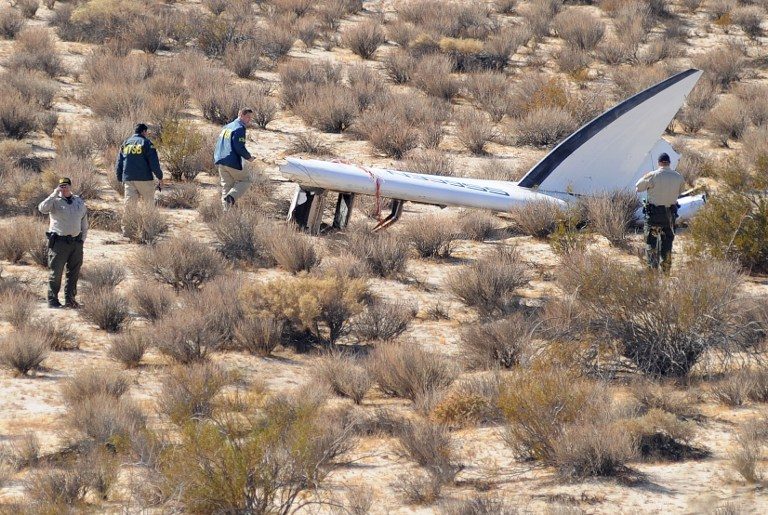SUMMARY
This is AI generated summarization, which may have errors. For context, always refer to the full article.

LOS ANGELES, USA – A prematurely deployed slowing device could “well be” behind the Virgin Galactic spaceship crash, Virgin’s boss Richard Branson said Monday, November 3, while hitting out at “hurtful” critics and “self-proclaimed experts.”
Investigators have pointed out that a lock-unlock lever, used to activate a process in SpaceShipTwo’s tail section – typically to slow it for re-entry into the Earth’s atmosphere – had been moved by the co-pilot.
A short time later a so-called “feathering” process – in which the tail section rotates to increase drag on the spacecraft – was deployed, at which point the pioneering vessel began to disintegrate.
‘Feathering’ deployed prematurely
It was unclear if the “feathering” – which acts like a badminton shuttlecock’s feathers, slowing the aircraft down during re-entry and pointing it in the right direction – started on its own or as a result of the lever being moved.
Investigators from the National Transportation Safety Board (NTSB) have emphasized the cause of Friday’s (October 31) accident in the Mojave Desert has not been established.
Branson, speaking on NBC’s Today show Monday, said he hadn’t seen the cockpit video showing the co-pilot triggering the lock-unlock switch.
“The NTSB, you know, are leading the investigation. And we go by exactly what they tell us,” he said.
“But, you know, if the deployment did take place early, obviously, they’re indicating that may well be the cause. But we need them to examine that further and let us know,” he added.
But Branson also hit out against “hurtful” critics and “self-proclaimed experts” after a rocket scientist said the company had ignored safety warnings ahead of the deadly crash of one of its spacecraft.
“I’ve never seen such irresponsible innuendo and damaging innuendo,” the British business tycoon told Britain’s Sky News television, referring to critical press reports in Britain.
“The fuel tanks and the engine were intact, showing there was no explosion, despite a lot of self-proclaimed experts saying that was the cause,” he said.
‘We must push on’
Carolynne Campbell, an expert with the Netherlands-based International Association for the Advancement of Space Safety, told Agence France-Presse on Sunday, November 2, that she and other experts “were concerned about what was going on at Virgin Galactic.”
She said multiple warnings about the spacecraft’s motor and the fuel used to power it had been issued to Virgin since 2007, when three engineers died testing a rocket on the ground.
“I warned them… that the rocket motor was potentially dangerous,” she said.
Campbell’s warnings related to nitrous oxide, reportedly used as a fuel component in the doomed craft along with a new substance derived from nylon plastic grains.
Branson wants to ferry wealthy customers to the edge of space, charging $250,000 (200,000 euros) per ticket, and the crash is expected to delay the program.
In his Sky News interview, he said: “We must push on.”
“I’m absolutely convinced that Virgin Galactic has a great future once the NTSB (US National Transportation Safety Board) has made clear exactly what happened,” he said.
But he stressed he would personally test the flight first. “We will not fly members of the public unless we can fly myself and family members,” he said.
A team of NTSB investigators has been deployed to the site of the crash, in which co-pilot Michael Alsbury was killed and pilot Pete Siebold was seriously injured.
NTSB acting chairman Christopher Hart told reporters on Sunday that a camera in the cockpit showed a lever had been moved by the co-pilot while the vehicle was traveling at a speed just above approximately Mach 1.0.
The lever, Hart said, was not supposed to be moved until reaching a speed of Mach 1.4.
“I am not stating this was the cause of this mishap. We have months and months of investigation to determine what the cause was,” Hart said.
One-year investigation
Witnesses to Friday’s crash say there was no obvious sign of an explosion before the suborbital craft broke apart and hurtled to earth shortly after it had detached from a mothership at an altitude of around 13,700 meters (45,000 feet).
The crash was the second disaster to rock the private sector space industry in less than a week, after an Antares rocket carrying supplies to the International Space Station exploded after takeoff in Virginia on Tuesday, October 28.
Experts say the accident will delay the advent of commercial space tourism by several years.
Hart said on-site investigations would last up to a week, but the full probe piecing together facts and analysis “will be probably 12 months or so.”
Wreckage from the crash was strewn over 8 kilometers (5 miles), according to Hart, who added that investigators hoped to find clues to the causes of the crash from the reams of data and video footage expected to be available.
The NTSB said it planned to hold its final press conference from the site at 8:00 pm Monday (0400 GMT Tuesday). – Rappler.com
Add a comment
How does this make you feel?
There are no comments yet. Add your comment to start the conversation.